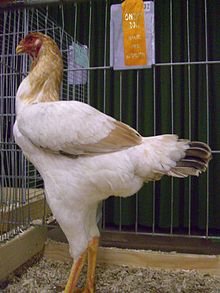Malay chicken
This article needs additional citations for verification. (May 2018) |
 | |
| Other names | Malay |
|---|---|
| Traits | |
| Weight | |
| Classification | |
| APA | all other standard breeds[2] |
| ABA | all other comb clean legged |
| EE | yes[3] |
| PCGB | Asian hard feather[4] |
| |


The Malay is a breed of game chicken. It is among the tallest breeds of chicken, and may stand over 90 cm (36 inches) high.[5] The Malay is bred principally in Europe,[3] and in Australia and the United States.[6] It was derived, partly in Devon and Cornwall in south-west England,[7] from birds imported from Indian subcontinent[5] or South-east Asia in the first decades of the nineteenth century, when large birds of this type were widespread in northern India, in Indonesia and in the Malay Peninsula.[8]
The Malay was the first chicken breed to be bantamised; a dwarf version of the standard-sized breed was created at the turn of the twentieth century.[1]
History[]
From about 1830 very large game chickens were imported to England, where they became fashionable[8] and were selectively bred by English breeders.[7] Some imports are documented from the Malay Peninsula, others from the Deccan of India.[9] Those from India were sometimes called Grey Chittagongs,[7] but were considered to be closely similar to the Malay. They were particularly numerous in Devon and Cornwall, especially in the area round Falmouth, which was a common first port of call for returning East Indiamen.[9] They were also numerous in Ireland, in the area of Dublin.[9]
Malays were shown at the first British poultry exhibition in 1845, and were included in the Standard of Excellence, the first edition of the British Poultry Standards, in 1865.[1][10]
Malay birds were present in Germany and the Netherlands by about 1834, and by 1846 were introduced to the United States also.[8] The black-breasted red Malay was included in the Standard of Perfection of the American Poultry Association from 1883, and the bantam in 1904; five other colours, both standard- and bantam-sized, were added in 1981.[2] Numbers of the breed in the USA are very low; its conservation status is listed as "critical" by the FAO.[6]
Characteristics[]
The Malay has an upright stance, a well muscled form and a large skull. Nowadays they are selected to be better egg-layers than in the 1970s with 70 to 120 eggs annually for a young hen and older hens laying only 30 to 55 eggs.
Use[]
Today, in the West the Malay is mainly kept for participation in poultry shows by breeders. It is considered a hard-feathered, gamefowl breed.
Malay chickens have been used in Brazil for the creation of the Índio Gigante Chicken.
References[]
- ^ a b c d Victoria Roberts (2008). British poultry standards: complete specifications and judging points of all standardized breeds and varieties of poultry as compiled by the specialist breed clubs and recognised by the Poultry Club of Great Britain. Oxford: Blackwell. ISBN 9781405156424. p. 169–71.
- ^ a b APA Recognized Breeds and Varieties: As of January 1, 2012. American Poultry Association. Archived 4 November 2017.
- ^ a b Liste des races et variétés homologuée dans les pays EE (28.04.2013). Entente Européenne d’Aviculture et de Cuniculture. Archived 16 June 2013.
- ^ Breed Classification. Poultry Club of Great Britain. Archived 12 June 2018.
- ^ a b Chris Graham (2006). Choosing and Keeping Chickens. London: Hamlyn. ISBN 9780600614388. p. 158–59.
- ^ a b Transboundary breed: Malay Game. Domestic Animal Diversity Information System of the Food and Agriculture Organization of the United Nations. Accessed August 2014.
- ^ a b c Chickens. Poultry Club of Great Britain. Archived 9 November 2018.
- ^ a b c Malay Chicken. The Livestock Conservancy. Accessed August 2014.
- ^ a b c William Wingfield, George William Johnson (1853). The Poultry Book: Comprising the Characteristics, Management, Breeding, and Medical Treatment of Poultry. London: W. S. Orr & Company.
- ^ William Bernhard Tegetmeier (editor) (1865). The standard of excellence in Exhibition Poultry, authorized by the Poultry Club. London: Poultry Club. p. 17–19
See also[]
- Chicken breeds
- Chicken breeds originating in Malaysia
- Animal breeds on the RBST Watchlist
- Poultry stubs